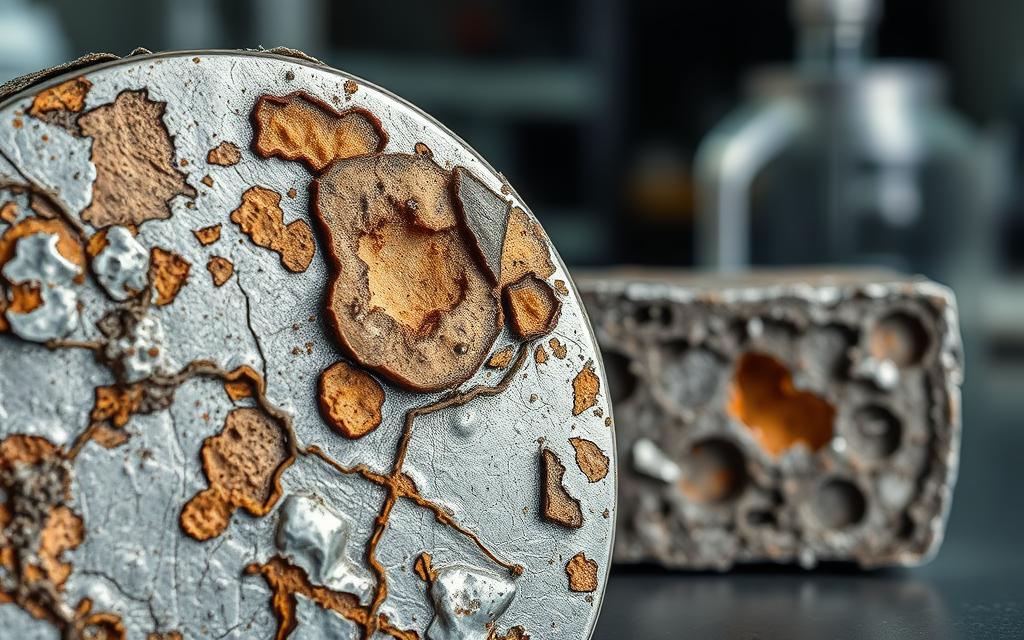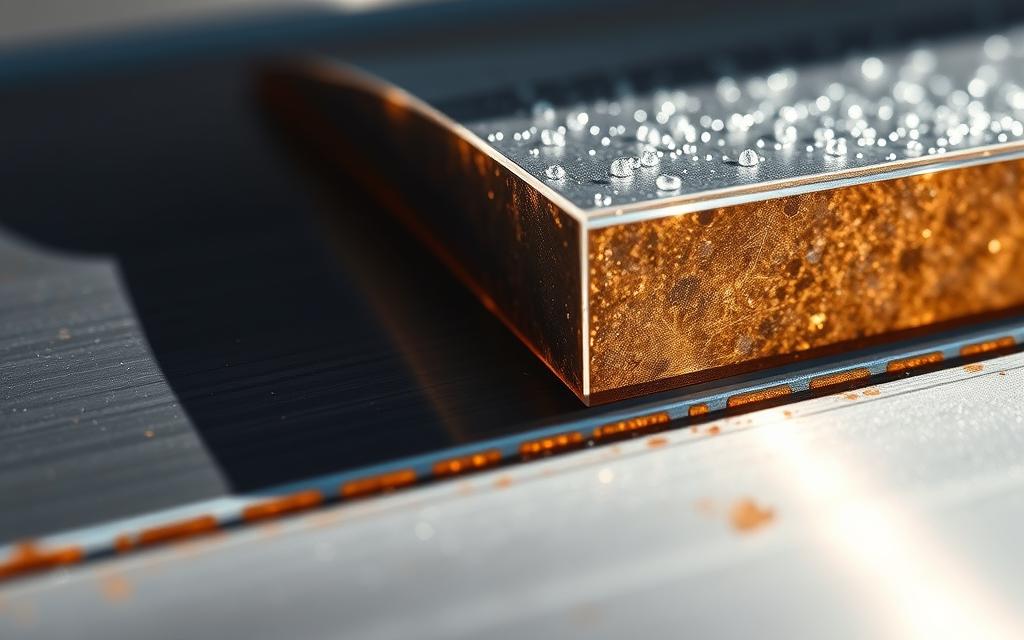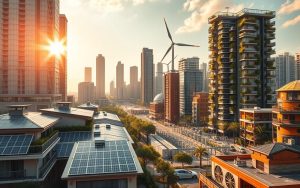Corrosion prevention technology is about stopping materials from getting damaged by the environment. It uses science and special coatings to protect things like bridges and pipes. This is very important for keeping our economy strong and people safe.
New ways to stop materials from getting damaged are more eco-friendly than old methods. For example, Stabilit’s FRP panels are made from special materials that last long and don’t need much upkeep. These new methods help save money and reduce waste.
How we protect materials from getting damaged has changed a lot over time. In the past, people used beeswax to protect metal. Now, we use advanced technology like nanotechnology. This shows how we’re moving from just fixing things to stopping problems before they start.
Today, we use smart sensors and green chemicals to fight damage. This makes protecting materials more effective and better for the planet. This shows how important corrosion technology is for a sustainable future.
Understanding Corrosion Technology
Corrosion technology is a mix of chemistry, engineering, and environmental science. It uses both prevention and repair to stop materials from breaking down. Let’s look at its basics and how anti-corrosion methods have changed over time.
Definition and Core Principles
At its heart, corrosion technology deals with managing electrochemical reactions between materials and their surroundings. These reactions happen when metals lose electrons to things like oxygen or water, creating harmful compounds like rust.
Today, we follow three main principles:
- Barrier creation: Protective coatings keep surfaces away from corrosive elements
- Electrochemical modulation: Methods like cathodic protection change the natural electrical charges
- Material selection: Using alloys or polymers that naturally resist corrosion
The materials science evolution has led to smart solutions like self-healing coatings. These coatings can fix themselves when damaged. An expert says:
“Modern corrosion control isn’t just about resistance – it’s about adaptive protection.”
Historical Development of Anti-Corrosion Methods
Older civilisations used simple but effective methods. The Romans used wine dregs to line lead pipes, and medieval blacksmiths made sealants from crude oil.
The 19th century saw big advances in cathodic protection history:
- 1824: Sir Humphry Davy tested zinc sacrificial anodes for ships
- 1906: The first commercial cathodic protection system was used for fuel pipelines
- 1930s: It became common in the US oil and gas industry
After the war, research on polymers changed coatings technology. Epoxy resins from the 1950s were very durable. Now, we have advanced inhibitors like DST-PAS. These use nanotechnology and eco-friendly chemistry, showing a focus on sustainability in materials science evolution.
Common Types of Material Degradation
Material degradation comes in many forms, each needing its own way to be managed. We’ll look at two main types: electrochemical corrosion and non-electrochemical mechanisms. Knowing these helps industries pick the right corrosion prevention methods for their challenges.
Electrochemical Corrosion Processes
Electrochemical reactions cause some of the most harmful material breakdowns. These happen when metals meet electrolytes like water or soil, creating corrosive paths.
Galvanic Corrosion
Galvanic corrosion happens when different metals touch in conductive places. For example, steel ship hulls can corrode fast when next to bronze propellers. The steel acts as the anode, protecting the bronze but losing itself. To stop galvanic corrosion, you can:
- Use insulators between metal parts
- Apply protective coatings on both sides
- Put sacrificial anodes on marine structures
Pitting Corrosion
Pitting corrosion makes small holes in metal, often unseen until it’s too late. Offshore oil platforms often face this due to salty seawater. The main pitting corrosion causes are:
- Chemical concentration differences
- Surface flaws
- Stagnant fluids

Non-Electrochemical Degradation Mechanisms
Some failures happen without electrochemical reactions, due to mechanical and environmental stress. These need different monitoring than usual corrosion.
Erosion-Corrosion
Erosion-corrosion is a mix of mechanical wear and chemical attack. For example, ammonia in poultry farm ventilation systems can quickly damage metals. To protect, focus on:
- Choosing alloys that resist erosion
- Lowering fluid flow speeds
- Doing regular surface checks
Stress Corrosion Cracking
Stress and corrosive environments can lead to big cracks. Pipelines are often at risk, due to temperature changes. Modern stress corrosion solutions include:
- Stress relief treatments
- Keeping the environment controlled
- Using advanced testing methods
Causes of Material Degradation
Understanding why materials fail is key. We must look at environmental wear, chemical reactions, and physical strain. These factors often work together, speeding up damage that costs industries billions.
Environmental Factors
Natural elements are big threats to material strength. Let’s look at two main environmental challenges:
Atmospheric Conditions
Coastal bridges face threats from humidity and salt spray. The Golden Gate Bridge needs 25,000 litres of paint each year to fight rust. Inland structures have their own dangers, like acidic rain that eats away at steel coatings.
Soil Composition Effects
Underground pipelines face hidden dangers from soil chemistry. Clay-rich soils with lots of moisture are perfect for galvanic corrosion. A 2023 study found 38% of oil pipeline failures in Texas were due to acidic soils (pH
| Soil Type | pH Level | Corrosion Risk | Common Mitigation |
|---|---|---|---|
| Sandy | 6.5-7.5 | Low | Cathodic protection |
| Clay | 4.0-5.5 | High | Epoxy coatings |
| Peat | 3.2-4.5 | Extreme | Fibreglass wrapping |
Chemical Exposure Challenges
Places where aggressive substances are handled need special chemical corrosion prevention. Sulphuric acid storage tanks show this fight:
- High concentration levels over 70% speed up metal thinning
- Temperature changes cause metal to expand and contract
- DST-CHEMICALS’ solutions cut attack rates by 83%
Mechanical Stress Impacts
Physical forces make materials weak, and environmental and chemical factors take advantage. Railway systems are a good example:
- Constant vibration loosens protective bolts
- Heavy loads over 25 tonnes cause metal fatigue
- Thermal expansion in welded tracks creates small cracks
This mechanical stress corrosion is behind 22% of rail repairs, according to the Federal Transit Administration.
Prevention Strategies in Corrosion Technology
Modern industries use corrosion-resistant materials like Stabilit’s Resolite CR-RFM panels to fight material decay. These panels are lighter than steel, by 40-50%, and last up to 20 years in tough conditions. Tests show they can handle saltwater, UV rays, and chemical spills well.
DST-PAS applications bring new ideas to farming. Opalit’s glass-reinforced polymer systems can handle fertilisers and acids without losing shape. Studies show they cut maintenance costs by 60% compared to old materials.
The move to composite materials is good for the planet. Making FRP needs 35% less energy than making aluminium. Places using these materials replace parts 75% less often, cutting down on waste.
Now, we mix old and new ways to protect things. Using coatings and new materials together makes things stronger. DST-CHEMICALS’ special concrete cuts corrosion by 90% in water plants and stays strong.
These new technologies change how we build things. Architects use Resolite panels for roofs where keeping moisture out is key. Farmers use DST-PAS in wet places. As science improves, so does how long things last in different fields.







